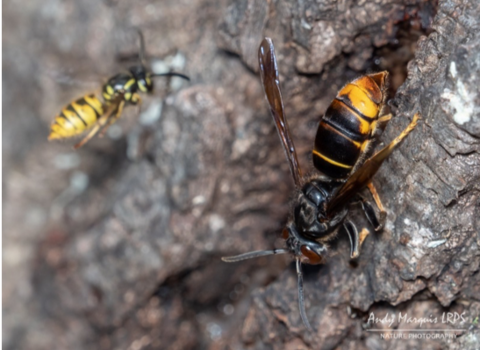The Asian hornet (Vespa velutina) is an aggressive predator of many types of insect but on average 30% of its diet is made up of honeybees. The Asian hornet is therefore a major threat to our biodiversity, pollinating insects, and beekeeping activities. It was first found in Alderney in 2017 and the States of Alderney are encouraging anyone who thinks they have seen an Asian hornet or found an Asian hornet nest to report it to the State’s Agricultural Team info@alderney.gov.gg. The AWT support the states team in their constant search for nests and often work in conjunction to help access and destroy less accessible ones.
What do Asian hornets look like?
Asian hornets have a distinctive velvety black/dark brown thorax. The abdomen is also black/brown with the abdominal segments bordered with a fine yellow band, only the fourth abdominal segment is almost entirely a yellow-orange. The legs are black/brown with yellow ends and the head is black with an orange-yellow face. A typical worker hornet is approximately 22mm (1 inch) in length.
There is further information about the biology and life cycle of the Asian hornet on the National Bee Unit website.
Are Asian hornets dangerous?
As with bees and wasps, the Asian hornet has a painful sting. The sting of an Asian hornet is no more harmful than that of a bee or wasp although if a person is allergic to bee or wasp stings they are also likely to react to the sting of an Asian hornet. However Asian hornets may act more aggressively than most other indigenous bee and wasp species if their nest is threatened so it is important not to deliberately provoke them. When foraging for food away from the nest the Asian hornet is no more aggressive than a normal wasp.
What you can do
Report any potential sightings of Asian Hornet in your garden and someone will come to check the species and remove the nest if there is one. Contact the States of Alderney.

